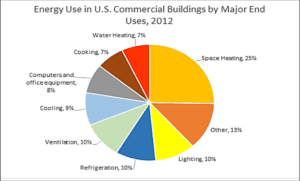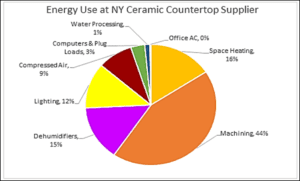Saving energy at your business
Where can your business save the most energy? It depends on what your business does, where you are located, and when you operate. When it comes to saving energy, some improvements make a much bigger difference than others.
For example, if you are a retail business, open six or seven days a week for 12 or more hours per day, then lighting—which is on the entire time—is a major expense. Your HVAC might be a bigger expense than lighting because heating, air conditioning, and ventilation use a lot of energy and can be operating just as long as the lights. If you are a retailer with refrigeration, such as a beverage distributor or grocery store, then refrigeration may exceed the lighting expense, especially because refrigeration is on 24 hours each day, 365 days per year. If you have a production shop, you may use compressed air for your tools, processes, or finishing. For ski areas, compressors use most of the energy a ski area consumes in a year. Other processes, such as welding, are similarly energy-intensive.
When Ambipar Response EMS conducts commercial energy audits, we look at all the energy contributors and determine the amount each function and each energy-consuming device contributes to your overall energy use to help determine the impact an improvement can have on your energy savings.
The chart below (click on the chart to enlarge) shows a composite of U.S. commercial buildings. It is important to note that this is a composite.

To address your needs, Ambipar Response EMS determines your actual energy use based upon your business, building(s), processes, operating parameters, and equipment. For example, below is a ceramic counter-top supplier’s specific energy use, which would suggest different areas of focus to achieve the maximum energy savings (click to the chart to enlarge).
Lighting
Once we know which energy consumers have the biggest impact, we assess whether and how much of an improvement can be made. For example, if you have old lights, upgrades are going to dramatically reduce the amount those lights consume, multiplied by the hours they are operating. Lighting is currently going through rapid improvements in technology that can result in 75 to 90% savings in energy use. With additional enhancements such as lighting controls, you could save as much as 95% of the energy used for lighting.
On the other hand, maybe lighting is only 5-10% of your electric bill, or maybe your lighting is already up-to-date. You could be spending a lot of money for not much improvement.
Heating, Ventilation, and Air Conditioning
Heating, ventilation, and air conditioning (HVAC) is the major consumer of energy in most buildings, and improving this area should yield the most savings. HVAC has fewer and more expensive solutions available to save the percentage of energy that lighting upgrades save. On the other hand, HVAC also has some opportunities for low cost changes that can make a significant difference due to its contribution to your energy bill. For example, if you are in a standalone office building operating 8:00AM to 5:00PM for five days a week, you might save 10 to 20% of your HVAC energy use simply by installing a programmable thermostat and programming it to relax the temperature control when the building is not occupied. However, the programmable thermostat will not help much if your building is always occupied or if you have a heat pump with electric resistive heating backup in a cold climate where you set it incorrectly. A ground-source heat pump can save 75% of the energy your HVAC uses, but it will require very expensive well drilling or field excavation. There are less dramatic solutions but still significant savings opportunities depending upon your existing HVAC equipment.
Building Envelope
It is also important to consider the building envelope in HVAC. The building envelope includes the walls, doors, windows, roof and floor. Depending upon the business operations and building type, there are many areas for improving the building envelope. These improvements can not only save energy but also help your building last longer and make working conditions healthier. If you had a perfect building envelope, an HVAC system would not even be necessary. All you would need is an Energy Recovery Ventilator (ERV) to bring in fresh air without heat loss. Unfortunately, most businesses do not operate in perfect building envelopes. People enter in the morning, leave later on; trucks dock and load and unload; windows absorb heat in the summer and radiate it in the winter. Nearly all buildings have many more losses of heat in the winter and heat gains in the summer to come anywhere near perfect. As a result, we use large energy consuming HVAC systems to maintain efficient comfort levels in the building. With some buildings, the answer is not to improve the HVAC equipment, but to fix the building envelope.
The building envelope is particularly important for businesses that need or create an especially dry or especially humid environment, such as for woodworking, pharmaceuticals, and stone and ceramic cutting. These humidity issues are often insidious and can destroy buildings over time.
Refrigeration
Refrigeration has many similarities with HVAC, but to higher extremes. Refrigeration uses a lot of energy to maintain a very different climate. Most of the same opportunities exist with refrigeration as they do with HVAC, but with savings that are more significant. More efficient evaporators and compressors can yield big savings. The refrigeration envelope also operates like the building envelope. The opportunities for improving a walk-in refrigeration or freezer space can be manifold. However, well-constructed refrigeration spaces typically yield smaller savings. This assessment is where Ambipar Response EMS can help separate the real improvements from the marginal improvements.
Compressors
HVAC units and refrigeration units both use compressors for cooling. It is ironic that this efficient use of mechanical energy to cool spaces is also used for one of the least efficient processes that exist in a production facility: compressed air for power tools and process air. Efficiency of a compressed air system can be as low as 10-15%. While some processes must use compressed air, many current equivalent electric tools are 90% efficient. There are also many ways to improve compressed air systems both from an equipment standpoint as well as from an operational standpoint. Ambipar Response EMS takes a system approach to compressed air (and everything else it assesses) to look beyond the compressor to take the air out of this considerable energy expense.
How to Save Energy at Your Business
The most energy savings can be from a single overlooked item or it can be from a combination of many smaller items. What is important is sizing up your particular circumstances and addressing what best fits your business. The savings can be significant while achieving other benefits for your operations, employees, and customers.
Ambipar Response EMS can help you find the most savings for the least cost and identify other benefits that may turn out to be even more important than the energy savings. If you have any questions about how to save energy at your business, please give us a call or contact us here. For more information about the energy services offered by EMS, check out these related articles:




I’ve always wanted to save energy so I could be more friendly to the environment. Thank you for letting me know that there opportunities for saving energy by having different cooling systems and different ways to run the refrigerator. I’ll need to look more into how I can be environment friendly, perhaps I can find someone to help consult me.